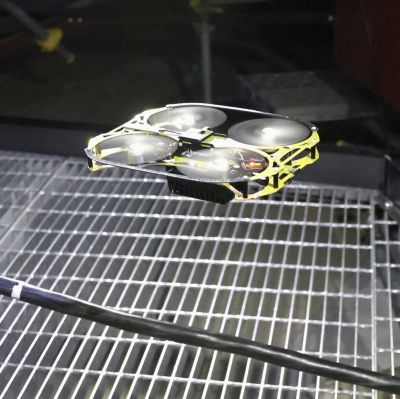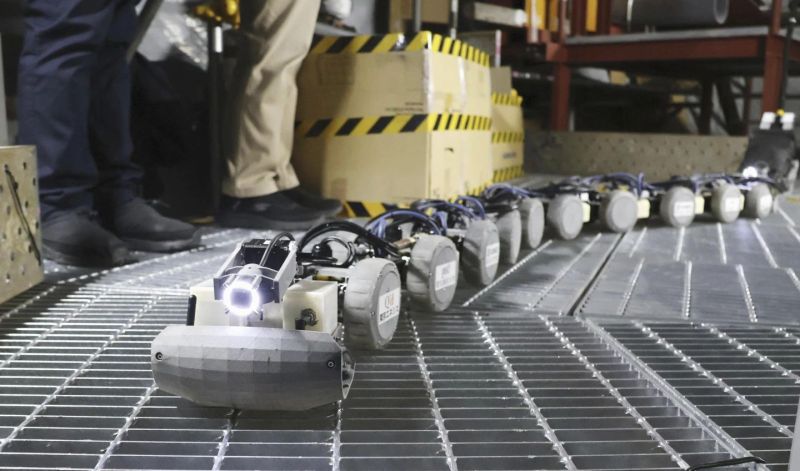During a press event on January 23rd, Tokyo Electric Power Company (TEPCO) demonstrated two new robots at the mock-up facility at Japan Atomic Energy Agency’s Naraha Center for Remote Control Technology Development (NARREC). As pictured by AP, one is a snake-like robot that should be able to reach very inaccessible areas, while four flying drones will be the first to enter the containment vessel of the Unit 1 reactor for inspection.

These flying drones are 20 cm across, weigh 185 grams each, and were adapted from an existing model that’s used for boiler inspections. At the Naraha Town facility, operators were able to practice flying it into a copy of the Unit 1’s containment vessel via the piping. As the most heavily damaged unit at the Fukushima Daiichi plant, engineers are interested to learn the details of the fuel and debris that has fallen to the bottom of the vessel so that the clean-up and decontamination steps can be planned.
Most of the current work inside the Fukushimi Daiichi reactor buildings is performed by robots, with the TEPCO gallery providing an overview of the wide range of the types used so far.
One of the first was the PackBot, from US-based iRobot, with many more following for a variety of tasks, from inspection to debris clearing and even dry ice-based decontamination.

















HAD recently had an article bemoaning the use of “robot” for just about everything and anything with a motor. To be fair, a bristlebot is the end of a toothbrush with a pager vibrator glued on – and people call this a robot.
How about a robot is something that does work on matter (move matter around, or modifies matter) without direct human control?
A 3D printer would then be a robot of sorts, just like the giant welding arms in automobile assembly lines are robots. The stock fetching machines at Amazon are robots, and so is a Roomba.
The machines in this article are remotely controlled sensors, so effectively RC vehicles with POV cameras, and not a “snake like robot”.
Unless the aforementioned article was rhetorical, in which case I feel silly trying to think about and make conclusions from reading it…
If the Hackaday article’s “going by the definition of the person who coined it” is the standard, you’ll find that almost all words in modern usage are used “wrong”.
To be fair, that happened very often in the past. How often had space probes been called “satellites” in the news?
I mean, if they’re not orbiting celestial bodies, they’re not exactly satellites. The Pioneers were remote controlled probes that had a course set that did lead them outwards solar system.
Such probes were sometimes called “robot probes” or “robots” , too.
Despite the fact (?) that they weren’t up until the Voyagers, which had a more autonomous operation.
Another thing is that the R/C devices in the article have “bot” in their product name. Even the company making them used “robot” term for itself.
So I can partly understand why the author did call them robots.
Still, your complaint isn’t invalid.
There’s a difference between a programmed robot and a remote-controlled sensor array.
In films, mechanical creatures are animatronics rather than robots, too.
Using words ‘wrong’ to expand their meaning beyond what the ‘manufacturer’ of the word specified…
Should fit here, right?
Using ‘devices’ of ‘things’ or ‘software’ wrong in ways that expands their functionality beyond what the manufacturer intended is a hack, why not hack words too?
Sure, the person on the other end of the conversation still needs to understand. So changing words until their meaning is no longer understood is a DoS at best and not a hack.
(That would make dadaist poetry into some sort of DoS on comprehension… I think)
MS-DoS or DR-DoS? 😁
Just kidding! 😋
I disagree and want my domestic washing machine re-classified as a robot please. Maybe it could also be used to de-contaminate nuclear power plant if somebody put it on wheels?
“How about a robot is something that does work on matter (move matter around, or modifies matter) without direct human control?”
That exactly what a bristlebot does (move matter around). Human just position it correctly.
I use it everyday.
LOL
So… Is a flying drone with, like, four big spinning rotors the right tool to explore an place that might have a lot of radioactive dust laying around?
Just asking for a friend.
How good is the wireless telemetry link? I’m guessing these types of buildings are made of reinforced concrete at the least, maybe full faraday cage construction even?
I’m a little rusty but modern RC stuff uses GHz which means the range will be about as good as a Wi-Fi router indoors. That is to say, crappy at best in a residential house.
I don’t know about these robots in particular, but a common practice is to place radio relays along the route. Sometimes the radios the vehicle uses can act as relays so an operator can move along the route until comms start deteriorating, then park that robot to use as a relay while the next robot goes farther in.